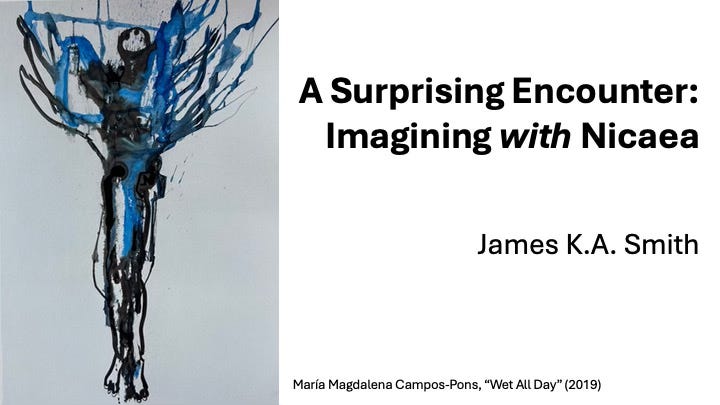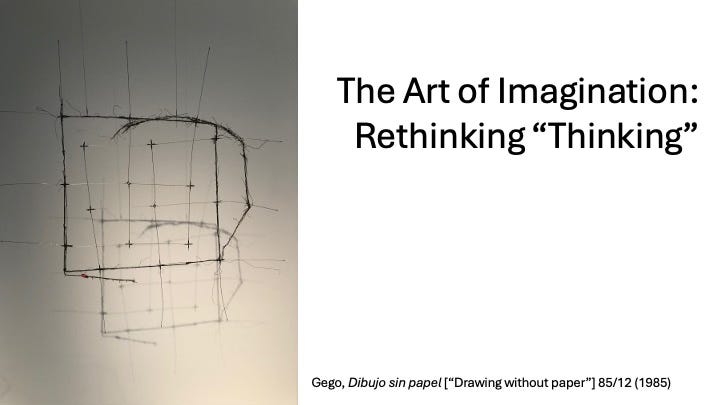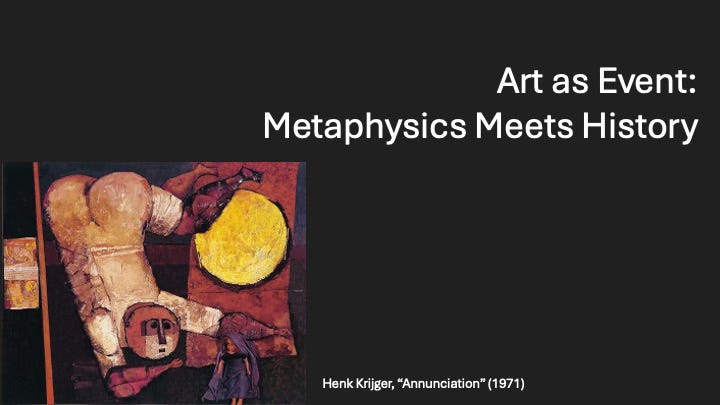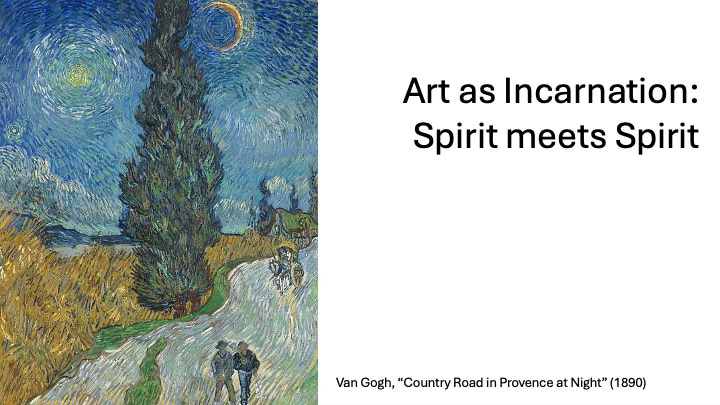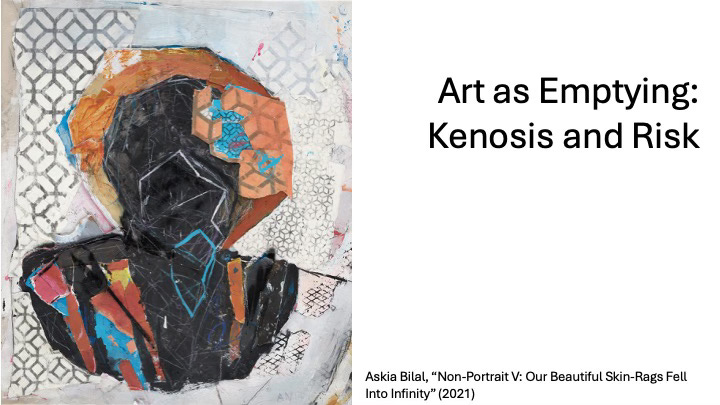Imagining with Nicaea
An encounter between theology & the arts
Below is the text (with slides) of an opening keynote lecture I gave yesterday at a conference organized by the Duke Initiative in Theology & the Arts called Visible and Invisible: Surprising Encounters between Theology and the Arts. The occasion is the 1700th anniversary of the Council of Nicaea in 325, one of the first ecumenical articulations of the Trinity and the doctrine of the Incarnation. What I can’t reproduce here is what followed my talk—a remarkable improvisational jazz performance by Julian Davis Reid and Nnenna Freelon.
Some of this talk anticipates themes from my forthcoming book, Make Your Home in This Luminous Dark: Mysticism, Art, and the Path of Unknowing (which, as the kids say, is available for pre-order).
Introduction: An Unthinkable Event
We are here to stage a perhaps surprising encounter between an ancient creed and contemporary art. This event is catalyzed by the singular fecundity of the creed generated in Nicaea 1700 years ago. The intuition behind this encounter, I think, is what we should see as the theological creativity of the Council’s work, bequeathing to us an understanding of God’s relationship to the world that is audacious, evocative, and pregnant with meaning and mystery. Encapsulated in the Nicene Creed is a cosmic vision that expresses with philosophical subtlety something that couldn’t be dreamt up by philosophy: that the “maker of heaven and earth, of all that is, seen and unseen…came down” and became human.
Thus the “event” in 325 that we commemorate was itself a reckoning with the more primordial event around which human history bends—the Incarnation of God as human, the descent and appearance of God in the flesh, both an actor in, and victim of, the vicissitudes of history. Nicaea was a reckoning with the unthinkable that nonetheless confronted humanity: that, in Jesus, God was with us in some new way. The incomprehensible reverberated from Bethlehem and Jerusalem and, almost three hundred years later, a community endeavored to articulate something of this mystery that left footprints in the mud and drops of blood on the ground and an empty tomb whose very abandonment kindled hope.
Paul Ricouer once said that “the symbol gives rise to thought.” In a similar way, we could say the community at Nicaea was provoked to a new sort of thinking by this surprising encounter with the unthinkable: God become human. In their imaginative wrestling with such a reality, the Council was not trying to “comprehend” it per se, but instead trying to take some measure of the spiritual and metaphysical and historical cataclysm in Bethlehem and Jerusulem—like trying to sound the depths of an unplumbable crater. It is an impossible endeavor, and yet—being the sorts of creatures we are, with an insatiable impulse to think and speak, to comprehend and confess—it is also an unavoidable task. In that sense (and I hope this isn’t heretical), to commemorate the Council of Nicaea is to recall a noble failure. (“One must obtain forgiveness for every essay in theology,” Jean-Luc Marion suggests.) And yet it is the sort of failure that is generative, that nonetheless reaches toward and touches the mystery that calls us, sustains us, saves us.
This, it seems to me, is why it makes sense for a community of artists to find ongoing nourishment in Nicaea. Reckoning with the unthinkable yet undeniable, Nicaea is a feat of faith-filled theological imagination that narrates the mystery of the incarnate God in a way that beckons, nourishes, and hallows the ongoing imaginative work of incarnation we call “art.” So in my brief time this evening, I want to consider just a few themes generated by the “surprising encounter” between God and the world reckoned with by Nicaea, and how the “surprising encounter” between Nicaea and the arts might reframe the vocation of the artist—and perhaps even the role of art in the human adventure of history.
A. The Art of Imagination: Rethinking “Thinking”
Nicaea is a reckoning with a historical event that required reconnoitering the very categories of thought. The testimony of the apostles and the kerygma of the church pointed to a reality that could not be comprehended with the available stock of concepts or within the strictures of existing logic—that Jesus, this historical human who suffered and died and (incredibly) rose again, was the Creator of the cosmos. This provocative rabbi, scapegoated by the state, was not just holy but divine. This surprising fusion of Creator and creature in the historical human, Jesus, could not be thought within existing logics. In Jesus, not only did justice and mercy meet; so too did mutual exclusives! Somehow, in Jesus, the Infinite is also finite, the absolute is also conditioned, the eternal dwells in time and history. How could this be? Are we mad if we confess this—literally irrational? No, the Council proposed. This event of Incarnation requires us to rethink our thinking. The Jesus-event is an earthquake that reverberates to reconfigure thought itself.
This is why at the heart of Nicaea is a feat of imagination. The formulation of the creed required a reimagining of thinking that, in some fundamental way, had to reinvent a different logic—what I have called “the logic of incarnation.”[1] What Nicaea rejected were attempts to reckon with the Christ-event[2] with available concepts and logic; because to do that—to try to “think” the enfleshed God with existing categories—was to always end up diminishing the cataclysm. Every attempt to “think” the Christ-event with existing logics ended up “resolving” the mystery of the Incarnation by reducing Christ to either the creature pole or the Creator pole—either Arianism or Docetism. When the Creed dares to confess that Jesus Christ is “begotten, not made, of the same being as the Father” and that “through him all things were made,” the Council ventured to think with a new logic. The logic of incarnation is provoked by the historical event of the Incarnation. It is a nonbinary, even dialectical, logic that refuses inherited either/ors, that transcends off-the-shelf categories. The Nicene Creed bears witness to a newly elastic imagination that, provoked by the Incarnation, begins to think identity and difference differently.
This, I would propose, is something that art also tries to do. Art refuses to be governed by binary logics or discursive conditions. What the law of non-contradiction rends asunder, art endeavors to hold together. This is why, as my teacher Cal Seerveld (now of blessed memory) put it, play is at the heart of art-making. Art refuses the binary logic of analytic precision and conceptual mastery. One of the joys and mysteries of art is its ability to hold together contradictions. Whether a painting or a song, a film or a poem, the most enduring art is the most capacious. The best artworks make room for the messiness of the world around us, the swirling complexity of the soul within, and even, sometimes, the infinite mystery of divine love. Like harmonies and chords, the most enduring works of art hold together complexities—they give us a way to live with, and into, tensions, even contradictions. Where a syllogism has to resolve to a conclusion, a poem remains open. (This is why poets are exiled from the Republic.) While a treatise has to make an argument, a sculpture can evoke fourteen feelings and seven ideas all at once, and all of them can be true.
When art lapses back into binary logics—when art allows itself to be governed by the policing forces of discursivity—the result is no longer art, but propaganda.[3] What does it look like for our art-making to be nourished by the nonbinary logic of incarnation—to dwell in and with the mystery with which Nicaea reckons?
B. Art as Event: Metaphysics meets History
One of the jarring features of the Nicene Creed is the surprising encounter between metaphysics and history. In its first lines we are taken, as it were, into the vault of heaven, into the inner sanctum of Triune life. We are sailing in what might feel like the Platonic realm of the Forms, the ethereal air of ousia, of substances and then plunged into the mud and the muck of creation. “For us…he came down.” He was crucified “under Pontius Pilate. He suffered death and was buried.”
The conceptual parsing that generated the confession of Christ as homoousion was not some flight from the world into abstraction. Instead, properly reckoning with Christ’s suffering, death, and resurrection propelled the Council into “speculation” in the best (Hegelian) sense of the world: trying to think in a way that reconciles opposites in order to make sense of our experience. If Trinitarian wrangling feels like a form of metaphysical speculation, it is prompted and demanded by this incredible historical reality: that “for us human and for our salvation,” God came down. I think this intersection of metaphysics and history is at the heart of Nicene Christianity.
In an essay on Beethoven’s operas, the critical theorist Theodor Adorno reflected on this essential connection between metaphysics and history. Adorno, whose outlook could be quite despairing, finds in Beethoven hints of a way the world could be otherwise. Or, at least, Adorno finds in Beethoven something that helps him make sense of our ineradicable desire for the world to be otherwise. We are never sky-hooked out of history, Adorno would (rightly) emphasize. We never get some standpoint above the fray. But, in the music of Beethoven, he admits that something transcendent flashes as a possibility in this world he experienced all too often as a prison. He puts it this way:
Metaphysics is not an unchanging realm to be grasped by looking out through the barred windows of the historical; it is the glimmer—albeit a powerless glimmer—of light which falls into the prison itself.[4]
I’m not suggesting artists should be waylaid by metaphysical speculation. I only mean to suggest that, in this surprising encounter with Nicaea, artists might consider the ways in which their art lets the light from beyond fall into our historical prisons. What if your art is a furtive glimmer of another world, or how this world could be otherwise?
I’m reminded of Bonhoeffer’s Letters from Prison, in which he constantly expresses how much he misses making music. In later letters, it’s clear that someone somewhere in the vicinity of his prison has a radio. Several times, he speaks of overhearing a symphony or aria on this distant, anonymous radio. Snatches of music arrive for him like the ravens that fed Elijah. Each moment is a sonic infusion of hope and humanity. What if your art might be someone else’s radio, wafting into spaces you’re not even aware of, allowing them to hear something other than all the tiresome voices in this building we call late modernity?
C. Art as Incarnation: Spirit meets Spirit
The incarnate Christ is the conduit of the Spirit, the giver of life. His ascension unleashes the scandalous deputation of humanity as bearers of the Spirit in history’s continued unfolding. The incarnate Christ is the nexus of communion between God and humanity. And now, in some significant sense, we, enlivened by the Spirit, are commissioned as “little Christs,” as C.S. Lewis once put it, to be ambassadors of communion and reconciliation.
The arts represent one of the most potent modes of such communion and reconciliation. Our encounter with Nicaea should alert us to the way that art can be an incarnate form of encounter—what we might think of as a “para-sacramental” means of grace by which the world is invited to encounter transcendence in matter. The “transcendence” I have in mind is not only “vertical” but also what we might call a “horizontal” transcendence: the genuine otherness of another human being in all their fullness and mystery. In a world bent on reducing us to machines, where even “intelligence” becomes artificial, encountering the surprising transcendence of another consciousness is like a foretaste of divine transcendence. Such communion of minds in the work of art is a “forerunner” (to use Evelyn Waugh’s metaphor) to a communion with the Spirit, the giver of life.
Two centuries ago, Hegel already gave us a way to appreciate this. In his lectures on aesthetics, he emphasizes the way art effects a communion of minds, of “spirit” (Geist) in Hegel’s language. Every work of art is minded, we might say—it is a working up and working over of materials that reflects the intentionality, reflection, and desire of the artist. At the same time, every work of art is material (“sensuous,” is how Hegel describes it). So every work of art is its own sort of incarnation. Every work of art, Hegel says, originates “from the spirit” and “belongs to the territory of the spirit; it has received the baptism of the spiritual.”
Contrary to the Romanticism of his day (and ours!), Hegel provocatively suggests that this spiritual baptism of the material work of art means that a landscape painting is superior to a mountain vista or stunning sunset. The landscape painting is a work of “spirit,” which means that it is a site or occasion for the communion of minds in a way that nature is not.[5]
I once heard my friend, the novelist Garth Greenwell, comment on his experience of seeing Van Gogh’s trees in a recent exhibit at the Met. “When I look at a tree,” he admitted, “a real tree out in the world, it does not seem infinite to me. I see a material thing. It doesn’t suggest something that dwarfs my ability to know. It seems to me that the tree is in some sense knowable. But when I go to the Van Gogh exhibit at the Met and look at Van Gogh’s paintings of trees, those trees feel infinite to me, they feel, finally, un-knowable. There is something in human consciousness, in Van Gogh’s consciousness poured out over cypress trees, in my consciousness receiving Van Gogh’s paintings, that feels infinite to me.” This, I think is a powerful testimony to art as a site of communion, an incarnate nexus in which spirit meets spirit, transcendence encounters transcendence. By cracking us open to this infinity, even if only initially the infinite mystery of another human consciousness, it seems to me art is an antidote to reductionism and the claustrophobia of naturalism. The encounter of spirit in a work of art pierces the prison of what Charles Taylor calls the “buffered self” of modernity. In doing so, it also cracks us open to the possible incursion of grace.
Like Hegel, we might think of every artwork as a site of incarnation. The work of art, he says, “stands in the middle between” sensuousness and thought, between body and mind. Inherently material, the artwork is also more than material; it is a site of “sensuous presence.” And when we encounter the work of art, we are both engaged by the material and pulled beyond it.
“These sensuous shapes and sounds appear in art not merely for the sake of themselves and their immediate shape, but with the aim, in this shape, of affording satisfaction to higher spiritual interests, since they have the power to call forth from all the depths of consciousness a sound and an echo in the spirit. In this way the sensuous aspect of art is spiritualized, since the spirit appears in art as made sensuous.”
The material artwork is not a ladder to be kicked away; rather, it is in the material that minds meet. The sensuous is a site for a communion of spirit.[6] Spirit recognizes spirit is the sensuous work of art—whether a symphony or a sculpture.
Our art-making will embody a “Nicene” sensibility, not by piously repeating or picturing sacred history but, instead, by endeavoring to be art that is suffused with human spirit that, in its fullness, is its own incarnate prelude encountering the divine.
D. Art as Emptying: Kenosis and Risk
Hegel, it should be noted, is an interpreter of Incarnation who rightly grasps the Incarnation in terms of kenosis, which brings me to a final theme. The Incarnation is an “emptying” of God into the vicissitudes of time and what Hegel described as the “slaughter bench of history.” “He came down,” the Nicene Creed confesses, not to parade in glory or float above the fray like some invincible wraith. The Incarnation of the Son is God’s exposure to suffering and death “for us humans and for our salvation.” Here, too, something about the very heart of God is revealed in the Incarnate Son: God with us is God who suffers with and for us. This is a radical moment of Nicene faith. Again, I think Hegel is a surprising interpreter of the implications of this fundamental aspect of our credo:
The life of Spirit is not the life that shrinks from death and keeps itself untouched by devastation, but rather the life that endures it and maintains itself in it. It wins its truth only when, in utter dismemberment, it finds itself. It is this power, not as something positive, which closes its eyes to the negative, as when we say of something that it is nothing or false, and then, having done with it, turn away and pass onto something else; Spirit is this power only by looking the negative in the face, and tarrying with it.[7]
If our art-making is its own sort of incarnation, then art that reflects Nicaea must be art that “looks the negative in the face.” It will be art that takes risks, including the risk of being misunderstood, perhaps even the risk of appearing unfaithful. I’m thinking, for example, of a poem like “Sparrows” by Bryce Taylor:
Sparrows
By Bryce A. Taylor
There was a girl in my high school always smiling
and the other day, in a bathtub, she shot herself.
Her mother was downstairs with her two little kids
whose universe will begin with that bang.
Somehow there’s still air in the lungs of earth
to blow through the reeds, and random sparrows
are still flying, the scarred eternal intellect
threading the spider that threads its orb web
to catch, immobilize, guzzle the juices. Yesterday
black vultures in my neighborhood quarreled
over rubbery pink remains of a squirrel run over
on a street where the kids play. The Manicheans
were onto something, separating the good god
from all of this, but you’re so stubborn, you
insist on hanging dead in the web and being
there, in the tub, not pulling the trigger maybe,
but kissing the wrinkled finger as it pulled.
There is no aesthetic tradition that has done this more powerfully than the legacy of Black music. As James Cone argued The Spirituals and the Blues, this musical legacy “unites the joy and the sorrow, the love and the hate, the hope and despair of black people; and it moves the people toward the direction of total liberation.” This rhymes with Nicaea.
Are we willing to tarry with the negative in our art-making—to descend, as the Incarnate God did, into suffering?
Without End: Ever Beginning
It is important to appreciate Nicaea as a beginning, not an end. As I’ve suggested, we might consider the Council’s work not so much as defining a boundary as aiming to preserve mystery. The Creed guards against false resolutions that all amount to reductions governed by a binary logic that can’t adequately absorb the wonder of the God-man. But this is a delineation that is meant to open up the mystery not domesticate it.
In his study, The Idea of Nicaea in the Early Church Councils, Mark Smith notes how under-determined the Creed was. It did not end a conversation; instead, it invited centuries of further reflection, wrestling, and wrangling. Subsequent Councils were a testimony to the plenitude of what Nicaea touched upon. “Nicaea’s capacity for flexible re-expression” is a testament to what we might call its apophatic wisdom—how much it leaves unsaid, how much of the mystery remains open. Subsequent reception demonstrated “how ‘Nicaea’ cold be both reaffirmed as sufficient and yet also acknowledged (even if not openly) as inadequate.”[8] Every generation can only engage in what Smith calls “creative re-reception” of Nicaea: “an ‘artefact’ such as the Nicene Creed, itself the product of specific circumstances and motivations, cannot simply be reaffirmed in a new time and context without remainder. Rather…it is an ‘open work’, ‘finished in its unfinishedness’, which must be encountered and received anew.”[9] One can see this dynamic at play in our own day in “Neo-Chalcedonian” discussions, in the wake of Maximus Confessor, about the role the Word plays in creation (“through him all things were made”) and whether we should understand creation itself as Incarnation.[10]
This “spirit” of Nicaea suggests why the Christian affirmation of the arts should always entail the celebration of contemporary art-making. Contrary to any Golden-Age-ism that nostalgically enshrines some past epoch, each generation is called to imagine anew. Each generation is called to incarnate the mystery for fresh contexts and new audiences. Each generation of artists to called to create and perform now, embedded in new contexts. Nicaea was its own improvisation, calling forth seventeen centuries of further improvisations. Every work of art is its own event of reception and improvisation. We will never be done making.
In the Incarnation, God became local—“moved into the neighborhood,” as Eugene Peterson memorably put it. Our neighborhoods, whatever and wherever they may be need, need you, artists, to incarnate the beauty and mystery of God—to give us songs to sing that rhyme with Nicaea.
[1] See James K.A. Smith, Speech and Theology: Language and the Logic of Incarnation (London: Routledge, 2002) and idem., The Nicene Option: An Incarnational Phenomenology (Waco, TX: Baylor University Press, 2021).
[2] I have always appreciated Oliver O’Donovan’s endeavor to say that what we reckon with in Jesus is a multi-momented “event” that is inclusive of incarnation, ministry, cross, resurrection and ascension (see Desire of the Nations). Any invocation of Jesus that leaves out one of these moments diminishes the fullness of the event that is Jesus.
[3] See Rainbows for a Fallen World.
[4] Cited in Peter Gordon, A Precarious Happiness, p. 43.
[5] “[O]wing to the feeling and insight whereby a landscape has been represented in a painting, this work of the spirit acquires a higher rank than the mere natural landscape. For everything spiritual is better than any product of nature.”G.W.F. Hegel, Aesthetics: Lectures on Fine Art, Vol. 1, trans. T.M. Knox (Oxford: Clarendon Press, 1975), 27, 29. A fascinating aside: Hegel entertains an objection, namely, the possibility that a direct encounter with nature is, in fact, an encounter with God, the “artist” of nature. This suggestion, Hegel replies, fails to understand the dynamics of God’s adventure as Spirit. “God is more honoured by what the spirit makes than by the productions and formations of nature,” because it is humanity’s spiritedness/mindedness, which finds expression in the emergence of culture from nature, that is most “God-like”: “in art-production God is just as operative as he is in the phenomena of nature; but the Divine, as it discloses itself in the work of art, has been generated out of spirit, and thus has won a suitable thoroughfare for its existence, whereas just being there in the unconscious sensuousness of nature is not a mode of appearance appropriate to the Divine (30).
[6] “[T]he work of art, as a sensuous object, is not merely for sensuous apprehension; its standing is of such a kind that, though sensuous, it is essentially at the same time for spiritual apprehension; the spirit is meant to be affected by it and to find some satisfaction in it.” Hegel, Aesthetics, 38-39, 35.
[7] Hegel, Phenomenology of Spirit, §32.
[8] Mark S. Smith, The Idea of Nicaea in the Early Church Councils, AD 431-451 (Oxford: Oxford University Press, 2018), 2-3.
[9] Ibid., 5.
[10] I’m thinking of Jordan Daniel Wood’s stunning book, The Whole Mystery of Christ: Creation as Incarnation in Maximus Confessor (Notre Dame, IN: University of Notre Dame Press, 2022).


